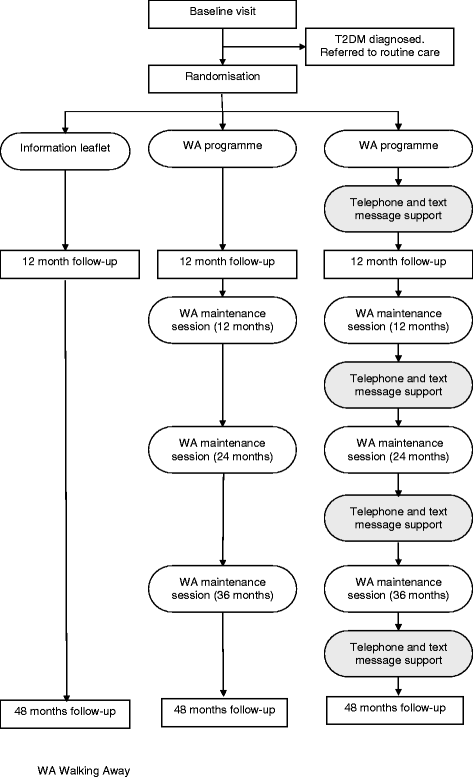PRomotion Of Physical activity through structured Education with differing Levels of ongoing Support for people at high risk of type 2 diabetes (PROPELS): study protocol for a randomized controlled trial
- PMID: 26130075
- PMCID: PMC4488033
- DOI: 10.1186/s13063-015-0813-z
PRomotion Of Physical activity through structured Education with differing Levels of ongoing Support for people at high risk of type 2 diabetes (PROPELS): study protocol for a randomized controlled trial
Abstract
Background: The prevention of type 2 diabetes is recognised as a health care priority. Lifestyle change has proven effective at reducing the risk of type 2 diabetes, but limitations in the current evidence have been identified in: the promotion of physical activity; availability of interventions that are suitable for commissioning and implementation; availability of evidence-based interventions using new technologies; and physical activity promotion among ethnic minorities. We aim to investigate whether a structured education programme with differing levels of ongoing support, including text-messaging, can increase physical activity over a 4 year period in a multi-ethnic population at high risk of diabetes.
Methods/design: A multi-centre randomised controlled trial, with follow-up at 12 and 48 months. The primary outcome is change in ambulatory activity at 48 months. Secondary outcomes include changes to markers of metabolic, cardiovascular, anthropometric and psychological health along with cost-effectiveness. Participants aged 40-74 years for White European, or 25-74 years for South Asians, with an HbA1c value of between 6.0 and < 6.4% (42 and 47 mmol/mol) or with a previously recorded plasma glucose level or HbA1c value within the high risk (prediabetes) range within the last five years, are invited to take part in the trial. Participants are identified through primary care, using an automated diabetes risk score within their practice database, or from a database of previous research participants. Participants are randomly assigned to either: 1) the control group who receive a detailed advice leaflet; 2) the Walking Away group, who receive the same leaflet and attend a 3 hour structured education programme with annual maintenance sessions delivered in groups; or 3) the Walking Away Plus group, who receive the leaflet, attend the structured education programme with annual maintenance sessions, plus receive follow-on support through highly-tailored text-messaging and telephone calls to help to aid pedometer use and behaviour change.
Discussion: This study will provide new evidence for the long-term effectiveness of a structured education programme focused on physical activity, conducted within routine care in a multi-ethnic population in the UK. It will also investigate the impact of different levels of ongoing support and the cost-effectiveness of each intervention.
Trial registration: ISRCTN83465245 Trial registration date: 14/06/2012.
Figures
References
-
- World Health Organization . Mortality and Burden of Disease Attributable to Selected Major Risk Factors. Geneva, Switzerland: World Health Organization; 2009.
-
- International Diabetes Federation. IDF Diabetes Atlas. http://www.idf.org/sites/default/files/EN_6E_Atlas_Full_0.pdf: IDF; 2013.
-
- Leung M, Pollack L, Colditz G, Chang S. Life Years Lost and Lifetime Healthcare Expenditures Associated With Diabetes in the U.S., National Health Interview Survey, 1997–2000. Diabetes Care. 2014; http://care.diabetesjournals.org/content/early/2014/12/18/dc14-1453.full.... - PMC - PubMed
-
- Department of Health and Public Health England . NHS Health Check Programme Best Practice Guidance. UK: DOH and Public Health England; 2013.
Publication types
MeSH terms
Associated data
Grants and funding
LinkOut - more resources
Full Text Sources
Other Literature Sources
Medical


